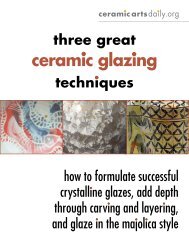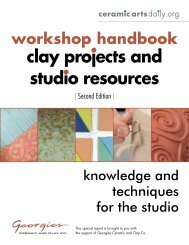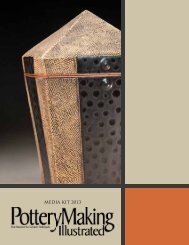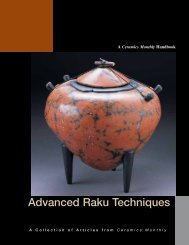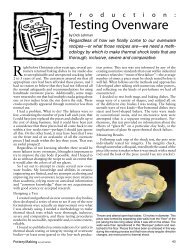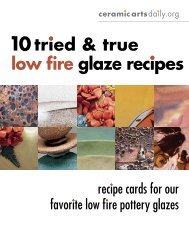Going Green - Ceramic Arts Daily
Going Green - Ceramic Arts Daily
Going Green - Ceramic Arts Daily
You also want an ePaper? Increase the reach of your titles
YUMPU automatically turns print PDFs into web optimized ePapers that Google loves.
GoinG<br />
<strong>Green</strong><br />
Artists Tap Alternative Resources to Fuel<br />
Their Creative Pursuits<br />
by Jon Ellenbogen<br />
<strong>Ceramic</strong>s Monthly December 2007<br />
28
focus sustainability<br />
Opposite: At EnergyXchange, in Burnsville, North Carolina, landfll gas—collected by an underground system of vents that feed<br />
an above-ground distribution valve—is used to fre kilns and glass furnaces, and to heat the work spaces.<br />
Above: The open, shared ceramics studio at EnergyXchange is meant to encourage not only effcient use of space, but effcient<br />
use of intellectual and creative ideas. Residents are meant to work together to solve technical and creative problems.<br />
Yancey and Mitchell Counties comprise a rugged, rural area in the<br />
northwestern corner of north Carolina. one would think that<br />
visitors to this beautiful Black Mountain range would be unlikely<br />
to make a stop at the old Yancey-Mitchell County landfll, but<br />
thousands of people have happily done just that over the last several<br />
years. on a small campus built just beside the now-closed landfll, an<br />
organization called energyXchange has built two craft studios and<br />
four greenhouses that utilize the continuous supply of landfll gas<br />
to fre kilns and furnaces and to heat the buildings. This visionary<br />
project, conceived in 1997 and opened for use at the end of 1999,<br />
has served as one of the nation’s model energy recovery projects for<br />
small rural landflls.<br />
The campus features a horticultural component and a crafts<br />
component. The horticulture portion includes four greenhouses<br />
and three cold frames for the production of endangered native orna<br />
<strong>Ceramic</strong>s Monthly December 2007<br />
29<br />
mental plants such as rhododendron and mountain laurel, with the<br />
greenhouses heated by landfll gas. The crafts component comprises<br />
a clay studio housing four pottery residents, a glass studio with two<br />
residents, a visitor center and a retail gallery space. naturally, all<br />
the buildings are heated with landfll gas and the kilns and furnaces<br />
use the gas as well.<br />
The CrafT residenCies<br />
The craft residencies at energyXchange represent a rare opportunity<br />
for talented and promising craftspeople to launch their careers as<br />
working artists. The program is designed as a small business incubator.<br />
The craft artists in clay and glass are selected by media-specifc<br />
juries for three-year terms. in return for modest rent, they receive<br />
a shared space in a fully equipped studio, access to the gallery and<br />
business center and use of the landfll gas at no additional cost. As
LandfiLL Gas and aLternative fueLs<br />
engineering studies have predicted about twenty years of gas<br />
production from a typical landfll. For a project such as energyXchange,<br />
the savings in fuel costs for the resident artists<br />
and greenhouse activities at the site could total approximately<br />
$2 million. naturally, the majority of this is attributable to<br />
the high energy demands of the glass studio.<br />
Signifcant cost savings can be realized by potters without<br />
access to a landfll through a variety of strategies and fuel<br />
choices. These can be divided into categories and discussed<br />
fueL<br />
deLivery<br />
& storaGe<br />
Burner systeM<br />
Heat density<br />
carBon iMpact<br />
in terms of benefts and diffculties. Solid fuels are diffcult,<br />
liquid fuels are moderate, and gases are easier.<br />
solid fuels<br />
Besides traditional wood firing, numerous attempts have<br />
been made to use sawdust to fuel kilns. This fuel occupies<br />
large volumes, needs to be delivered to the site of the kiln,<br />
must be kept dry, and has to be fed to the firebox in a con<br />
tinuous and controlled manner. it’s the delivery system to the<br />
firebox that generally proves to be difficult. Professor Lowell<br />
Baker at the University of Alabama Art Department has de<br />
veloped a sawdust injection system. information is available<br />
on his research page at http://bama.ua.edu/~wbaker/Main.<br />
Another source of information is the book Handbook of<br />
<strong>Ceramic</strong>s Monthly December 2007<br />
30<br />
Homemade Power, published by Mother earth news, and<br />
available on Amazon.com.<br />
Liquid fuels<br />
Many potters are utilizing a variety of liquid fuels such as<br />
french fry oil from restaurants, crankcase drain oil from automobiles<br />
and home heating oil. The simplest confgurations<br />
can be described as drip systems, in which one of these liquids<br />
is dripped in a fne stream directly into a propane or natural<br />
aLternate and renewaBLe fueLs for potters<br />
soLid Liquid Gas<br />
Sawdust Oils Landfll Gas,<br />
Compost Gas<br />
Manufactured<br />
Gas<br />
Propane,<br />
Natural Gas<br />
Diffcult Collected by User Complex Simple<br />
Complex Drip: Simple<br />
Atomized: Complex<br />
Complex Simple<br />
Low Moderate to High Low High<br />
High High Low Moderate<br />
gas burner fame, thus boosting the heat delivered to the kiln.<br />
Such systems are simple and inexpensive to build but require<br />
constant monitoring during use. Combustion is incomplete<br />
(possibly good for reduction frings) and therefore likely to<br />
contribute to global warming and cause some air pollution.<br />
Burning crankcase drain oil likely presents environmental<br />
hazards and cannot be recommended.<br />
For effcient burning, liquid fuels must be precisely atomized<br />
and require complex mechanical pump-driven burner<br />
systems. Bakersville, north Carolina, potter Kent McLaughlin,<br />
among others, is successfully using an electrically driven<br />
mechanical burner to supplement a propane-fred Cone 10<br />
reduction kiln with fry oil he collects from area restaurants<br />
(see “French Fried Pots” on page 32). Fry oil must be gath
ered, screened and preheated before it can be used in a pressure<br />
burner system. Though it is “free” right now, supplies will become<br />
squeezed as biodiesel fuel becomes more common.<br />
Gaseous Fuels<br />
Manufactured gaseous fuels remain the most practical for potters.<br />
Propane and natural gas are simple to store and to deliver, burn<br />
efficiently with inexpensive burner systems, and are generally<br />
trouble free. Renewable gaseous fuels, with landfill gas being only<br />
one source, present greater challenges. Composters can be constructed<br />
on almost any scale and the resulting gas utilized much<br />
like landfill gas, with the major challenge being the complexity<br />
of collecting compostable materials on a sufficiently large scale<br />
and the difficulty storing such gas production. Currently only<br />
municipalities can deal with composting on a scale sufficient to<br />
result in usable gas production.<br />
Other Cost-Saving Strategies<br />
Many studies have shown that lowering the firing temperature<br />
of a typical glaze firing from Cone 10 to Cone 5 could save<br />
25-35% in fuel costs while reducing the impact on the planet.<br />
Consequently, such an adjustment would be both a socially<br />
responsible and economical choice.<br />
Heat recuperation is another approach to fuel savings. This<br />
involves a heat exchanger built into the flue or chimney of a kiln<br />
to use the heat of the escaping flue gases to preheat the combustion<br />
air. Such processes are widely used in industry but not normally<br />
considered by studio artists. Interesting work is currently<br />
underway in Hawai‘i by glass artist Hugh Jenkins (see “Volcano<br />
Kiln” on page 36). Since propane in Hawai‘i currently costs $3.20<br />
per gallon the incentives for recuperation are obvious.<br />
Landfill Gas Energy Projects Nationwide<br />
410 Operational Landfill Projects<br />
575 Candidate Landfills<br />
tO Learn mOre . . .<br />
If you are interested in starting a landfill partnership<br />
project in your area, visit the Environmental Protection<br />
Agency’s Landfill Methane Outreach Program website<br />
at www.epa.gov/lmop.<br />
<strong>Ceramic</strong>s Monthly December 2007<br />
31<br />
focus sustainability<br />
Lady Vase, 9 in. (23 cm) in height, stoneware, fired to Cone 10 in reduction,<br />
$65; by Lindsay Rogers, EnergyXchange resident, Burnsville, North Carolina.<br />
an added benefit, the craft artists receive small business training<br />
classes, which are provided on site and totally free. The six<br />
resident artists share the job of staffing the gallery, greeting<br />
visitors, and handling sales of the work. Because the site has<br />
attracted numerous people and tour groups, the residents have<br />
enjoyed excellent sales from more than 5000 annual visitors.<br />
All of the residents are free to participate in the community<br />
activities of nearby Penland School of Crafts, a significant<br />
source of stimulation, ideas and contacts.<br />
Shared StudiOS<br />
The four potters who share the clay studio have discovered<br />
numerous benefits beyond the obvious use of the building<br />
and equipment. No potter makes continuous use of kilns,<br />
extruders, slab rollers and the like, so little compromise results<br />
from sharing such items. But the residents at EnergyXchange<br />
identify their greatest benefit as the sharing of ideas, skills and<br />
experiences. They have found that working in a group setting<br />
helps them resolve production challenges, aesthetic problems<br />
and business difficulties. Each resident can leverage his or her<br />
skills through the experiences of the others, thereby making<br />
progress along a career path that would have taken longer if<br />
operating solo.<br />
Perhaps the lesson learned from this experience is that, in<br />
the post-modern world, the idea of the artist working alone in
i am fortunate to live in a very rural area that has several din<br />
ers that use vegetable oil to fry several of the menu entrées.<br />
initially, i placed a 30-gallon plastic barrel outside one such<br />
diner that had agreed to save the used oil for me. My plan<br />
was to swap out the barrel every fve weeks (the owner<br />
predicted it would take that long to fll the<br />
barrel) and<br />
replace it with an empty 30-gallon barrel.<br />
i learned two facts immediately: First, i<br />
fow valve<br />
couldn’t lift the full barrel of oil onto<br />
the back of my pick-up truck.<br />
Secondly, used, hot oil will<br />
melt plastic barrels.<br />
i modifed my plan by pur<br />
oil gravity feed from<br />
chasing a manual bilge pump from<br />
storage drum<br />
West Marine (model # 2845519,<br />
$36.99) and simply pumped the oil into<br />
an empty barrel on<br />
the truck. once the oil was home, i used<br />
5-gallon buckets to<br />
offoad the oil into larger barrels for later<br />
processing.<br />
After searching for other sources of<br />
oil, i found a diner that<br />
replaces the used oil back into the original<br />
small plastic jugs<br />
that it came in. The smaller containers<br />
eliminated the need for<br />
the bilge pump and barrels and greatly<br />
simplifed the gathering<br />
process. Before using, the oil requires<br />
fltering to remove any<br />
All Carbon is not Equal<br />
A few years ago, when I seriously began to explore this<br />
fuel for the kiln, I came across a student’s masters thesis<br />
dealing with vegetable oil. A portion of the discourse dealt<br />
with poly-unsaturated and saturated oils used in cooking.<br />
Further searching led me to a way more information than<br />
I wanted or needed. The one thing I learned was that these<br />
fuels have more carbon atoms in their molecules than pro -<br />
pane. This also coincided with my carbon trapping shino<br />
glaze period. I thought the two would be a perfect match.<br />
I discovered that although there may be more carbon<br />
atoms in the oil molecules, the bond between the carbon<br />
atoms seemed to be much stronger, freeing up less carbon<br />
to trap on the shino glaze. The initial frings produced very<br />
little carbon trapping. Now, I fre the kiln using oil and with<br />
the propane burners throttled way back and the primary air<br />
almost closed to help create a reducing atmosphere. I’m<br />
very happy with those results.<br />
frencH fried pots<br />
by Kent McLaughlin<br />
air inlet grate<br />
<strong>Ceramic</strong>s Monthly December 2007<br />
32<br />
oil drip tube<br />
The turbine pulls air<br />
in through the back<br />
of the burner and<br />
forces it out the front<br />
around the atomizing<br />
nozzle.<br />
The brass atomizing<br />
nozzle spins<br />
with the turbine at<br />
a high speed, and<br />
uses centrifugal<br />
force to atomize<br />
the oil as it exits<br />
through the front<br />
of the nozzle.<br />
food particles. My flter is a homemade porcelain bowl<br />
(14½ inches wide × 5 inches deep) intended to be a sink<br />
with a 2-inch drain hole in the bottom. it fts perfectly over<br />
a 5-gallon pail. i used JB Weld to glue a 40-mesh stainless<br />
steel screen over the hole to act as a flter. When the pail<br />
is about half full of the fltered oil, i then pour it into my<br />
55-gallon drum. The fltering/pouring process continues<br />
until the 55-gallon drum is about three quarters full. This<br />
ensures that there is plenty of fuel for the fring.<br />
once the kiln is preheated with propane to Cone 012,<br />
the oil burner is placed into its burner port and started.<br />
The heat in the kiln will ignite the oil. i use around 25<br />
gallons of oil when i fre the kiln. The BTU rating on fry<br />
oil is approximately one and a quarter times that of pro<br />
pane so i estimate a savings of about 30 gallons of propane<br />
per fring. My frings are in the Cone 10+ range. The fuel<br />
cost savings are just a part of this equation. Some of my<br />
other considerations are renewability, sustainability, using<br />
a domestic fuel source and environmental concerns.<br />
Kent McLaughlin will be teaching a course on vegetable<br />
oil fring at Penland School of Crafts in Spring 2008. For<br />
more information, visit www.penland.org.
sHare and sHare aLike<br />
Though hard to quantify,<br />
the cost benefts of shared<br />
studios include the following:<br />
• One fully equipped studio serves four<br />
potters—one structure means one<br />
utility bill, one telephone bill, one<br />
heating bill, etc., split four ways<br />
• Shared materials purchases with<br />
resulting discounts<br />
• Shared cost of equipment maintenance<br />
when required<br />
• One gallery space with shared<br />
monitoring responsibilities<br />
• Visitors come to the gallery for multiple<br />
purposes, resulting in leveraged<br />
visibility for each potter<br />
• Shared computers, fax, copier, Internet<br />
account and credit card terminal<br />
an individual studio is becoming obsolete and that<br />
cooperative studio settings could be the way of the<br />
future. Think of the diminished environmental<br />
impact of fewer buildings, reduced use of materials<br />
and smaller infrastructure demands.<br />
COLLeCTinG The Gas<br />
At energyXchange, landfll gas is collected by wells<br />
that are drilled down from the surface nearly to<br />
the bottom of the landfll. These wells are simply<br />
perforated plastic pipes that have been placed into<br />
the center of four-foot diameter holes lined with<br />
crushed rock. The decomposing garbage produces<br />
gas that is drawn into the pipes, which are con<br />
nected via manifolds to an electric blower that<br />
pushes the gas to the buildings and studios where it<br />
will be used. The six-acre landfll at energyXchange<br />
used six wells initially, but several more have been<br />
added in recent years.<br />
There are more than 900 other small rural<br />
landflls in America that could be converted to<br />
energy sources, and energyXchange has inspired at<br />
least thirteen similar projects throughout the US.<br />
Large landflls can produce prodigious quantities of<br />
landfll gas, and the BMW automobile factory in<br />
Spartanburg, South Carolina, is currently utilizing a<br />
300-acre landfll to meet all of its natural gas needs.<br />
The University of north Carolina at Asheville is<br />
Carved Vase, 2007, 10 in. (25 cm) in height, thrown, altered and<br />
carved porcelain, fred to Cone 10 in reduction, $140; by Emily<br />
Reason, EnergyXchange resident, Burnsville, North Carolina.<br />
<strong>Ceramic</strong>s Monthly December 2007<br />
33<br />
focus sustainability
oHio vaLLey creative enerGy:<br />
turninG trasH to treasure<br />
Similar in mission to energy Xchange, ohio Valley<br />
Creative energy (oVCe) is a grassroots, nonproft<br />
organization based in the Louisville, Kentucky,<br />
region. oVCe is currently in the planning stages of<br />
designing and building an effcient and innovative<br />
green building to house “fre art” studios powered<br />
by landfll gas and other renewable sources at the<br />
Clark-Floyd Landfll area in Southern indiana.<br />
oVCe plans to use waste heat to power a small<br />
refnery that will produce biodiesel to power shuttles<br />
for artists and tourists, and the dump trucks that un<br />
load at the landfll. They also plan to recuperate waste<br />
heat so that it takes less fuel to power equipment and<br />
heat offce/community spaces<br />
and greenhouses.<br />
“everything we do—<br />
from studio design to<br />
equipment and systems<br />
technology (see “Volcano<br />
Kiln, Page 36), architectural<br />
design and planning<br />
to energy use—will take<br />
ecology into account,”<br />
says oVCe project direc<br />
tor/founder Lori Beck.<br />
“A carbon budget will be<br />
balanced with a monetary<br />
budget. We hope to pro<br />
vide insight and reason<br />
for all visitors and artists<br />
to consider shifting to a<br />
more green lifestyle.”<br />
The oVCe project<br />
is the frst community/<br />
commercial landfll gas<br />
partnership. in addition<br />
to fnancial support, Hoo<br />
sier energy, the major<br />
corporate partner, will run a two mega watt electricity<br />
generation station that will provide green power to area<br />
consumers and donate all excess power to oVCe.<br />
“This is important because it sets a standard for<br />
the rest of the industry, making the commercial end<br />
users more aware of the potential community uses<br />
of this resource. This is about community working<br />
together, and holding corporate America account<br />
able. This is a good sign.”<br />
<strong>Green</strong> studio HaBits<br />
Architect Doug Pierson of (fer)—form environment research—<br />
studio, a progressive design studio located in Los Angeles,<br />
California, is working with OVCE to design all the buildings,<br />
including the “fre arts” studios. Pierson offers this advice for<br />
designing a green studio space:<br />
• Design an open foor plan. Several sectioned rooms create<br />
many microclimates, which can overwork heating and air<br />
conditioning. Multipurpose space means you need less space.<br />
• Use rapidly renewable materials (those made from<br />
living things with a life cycle of ten years or less). Bamboo,<br />
wheatboard (similar<br />
to medium density<br />
In addition to Pierson ’s recommendations for studio<br />
design, here are some steps you can take to lessen your<br />
environmental impact:<br />
• Recycle all raw clay (or even dig your own clay)<br />
to reduce the amount of mined, packaged and<br />
shipped material.<br />
• Save reject bisqueware and crush it into grog. This<br />
is particularly useful when you don ’ t want<br />
your fnished<br />
pieces to have the grog color show through.<br />
• If you have a garage studio with no running water,<br />
a graywater (rainwater) collection system can provide<br />
the water you would otherwise haul from your house,<br />
thereby reducing the amount of water that needs to be<br />
treated. If you need hot water in the studio, a tankless<br />
water heater could be used.<br />
• Use an oxygen probe to ensure you fre as effciently<br />
as possible (see “Striving for Perfection” on page 37).<br />
• Consider fring with waste vegetable oil (see<br />
“French-Fried Pots” on page 32).<br />
34<br />
fberboard, or mdf)<br />
and sunfower seed<br />
board can be used<br />
instead of gypsum,<br />
meaning less mining<br />
of raw materials.<br />
• If you use<br />
wood, check to see<br />
if your local lumber<br />
company stocks<br />
Forest Stewardship<br />
Council certifed<br />
lumber. This is<br />
typically veneer<br />
plywood and solid<br />
hardwoods.<br />
• Purchase tradeable,<br />
renewable<br />
energy certifcates<br />
(RECs). Calculate<br />
the amount of<br />
energy your studio consumes (in kilowatt hours), and purchase<br />
that much energy or renewable energy certifcates.<br />
To learn more about renewable energy certifcates, visit<br />
www.eere.energy.gov/greenpower.<br />
• Use low-voltage, compact fourescent or LED (light<br />
emitting diode) fxtures. LED technology now includes replacement<br />
bulbs for traditional incandescent A-type fxtures.<br />
<strong>Ceramic</strong>s Monthly December 2007
currently designing an ambitious crafts campus adjacent to<br />
the city’s landfll, to utilize that gas and other “green” energy<br />
sources. in addition, ohio Valley Creative energy in Borden,<br />
indiana, (near Louisville, Kentucky) is in the development<br />
stages of a green arts center (see opposite page).<br />
LandfiLL Gas ChemisTry<br />
Landfll gas results from the decomposition of organic matter<br />
in the buried garbage in a landfll, provided there is suffcient<br />
moisture. Though the gas composition can vary from place<br />
to place (and even from day to day) it is typically about 55%<br />
methane, 40% carbon dioxide and 5% other gases. The landfll<br />
gas is lighter than air and will escape into the atmosphere, or<br />
it can be collected through a series of horizontal or vertical<br />
pipes, or wells.<br />
Methane is known to be a greenhouse warming gas, so the<br />
release of methane into the atmosphere is harmful to the planet.<br />
Burning the methane in an open fame results in carbon dioxide<br />
and water vapor. Though carbon dioxide is also a greenhouse<br />
warming gas, methane is about 21 to 25 times more harmful,<br />
so combustion of the landfll gas is benefcial. According to<br />
an ePA feasibility study, the benefcial environmental impact<br />
of the Yancey-Mitchell County Landfll Project is equivalent<br />
to planting 14,000 acres of trees or taking 21,000 cars off the<br />
road in north Carolina.<br />
firinG WiTh LandfiLL Gas:<br />
free, BuT nOT easy<br />
Compared to propane or other gaseous fuels, landfll gas has a<br />
low heat content—think of it as half-strength natural gas. in a<br />
landfll, gas is generated continuously but at very low pressure,<br />
so large volumes must be delivered to a kiln or furnace through<br />
large diameter piping and blower systems. This requires a kiln<br />
designed for greater volume fowing both in and out.<br />
Secondly, it is corrosive, so metal parts in contact with<br />
the gas must be monitored and replaced continuously, even<br />
if they are stainless steel. Thirdly, it will not sustain a pilot<br />
light nor can it be ignited by spark, so standing pilots must<br />
be propane or natural gas powered. it should be mentioned<br />
that in a small, rural landfll it is not cost effective to store the<br />
gas that is produced continuously, nor is it practical to purify<br />
it. Consequently any excess (above the amount in use by the<br />
facility) is burned in an open fame, with the benefts to the<br />
planet mentioned above.<br />
Because of its lower heat content, kiln frings always take<br />
longer than with other fuels and require more attention<br />
throughout. Gas production varies with time of year, weather,<br />
and even time of day, and “fring by formula” is not practical.<br />
Because of lower heat input to the kiln it is prudent to reduce<br />
any heat losses, so the kiln is surrounded by an effective wind<br />
break and is extra-well insulated.<br />
For more information, please visit www.EnergyXchange.org or<br />
contact executive director Heather Dawes at (828) 675-5541.<br />
35<br />
focus sustainability<br />
Vase, 13 in. (33 cm) in height, glazed stoneware, $80;<br />
by LeAnne Ash, EnergyXchange resident, Burnsville, North Carolina.<br />
<strong>Ceramic</strong>s Monthly December 2007
HuGH Jenkins’ voLcano kiLn:<br />
recuperatinG waste Heat for efficient firinG<br />
As a studio artist, it is often hard to spend large sums of money, even if doing so<br />
would pay off in the long run, so glass artist Hugh Jenkins set out to determine just<br />
how well he could do with a home-built heat recuperator. After several improvements,<br />
he discovered that, depending on how much fuel he used, recuperating<br />
hot air in a closed system can reduce fuel consumption by up to 80%. He then<br />
applied what he learned when helping a friend build a kiln for ceramics. one of<br />
the biggest factors in the performance of these units is a very tight-ftting door.<br />
Any gaps can signifcantly cut the effciency of the heat exchanger.<br />
Hugh Jenkins is working with OVCE (page 34) on sustainable<br />
equipment design. He is available for workshops, and further<br />
information can be found at www.bigislandglass.com.<br />
1. The recuperator is installed at the top<br />
of the stack and consists of a mullite tube<br />
that carries the kiln exhaust, surrounded<br />
by a metal tube that is several inches<br />
larger in diameter than the mullite tube.<br />
This forms a cylindrical channel that is<br />
open at the top, through which outside<br />
air enters the system. The air is heated<br />
by the mullite tube and is pulled down<br />
into the primary air channels in the brick<br />
stack and kiln wall.<br />
damper blade<br />
between fue<br />
stack and<br />
exhaust tube<br />
2<br />
3<br />
compressed air<br />
blows through a<br />
venturi carved into<br />
the soft brick<br />
1<br />
1<br />
2.<br />
The chimney is a doublewall<br />
structure. Flue exhaust<br />
travels up the center to the heat<br />
exchanger, and heated air from<br />
the exchanger travels down the<br />
outer chamber to the primary<br />
air channels in the back wall of<br />
the kiln. Air is drawn through<br />
the sytem by compressed air<br />
(3) at the bottom of the stack.<br />
4<br />
arrows indicate<br />
recuperated<br />
heat fow<br />
fue<br />
opening<br />
4. The burner blocks are made of<br />
castable<br />
refractory. The bottom hole<br />
is for a pilot burner, and the top<br />
houses the main venturi burner.<br />
Each fts into the block exactly,<br />
so that the only air used is the<br />
recuperated, heated air delivered<br />
through the primary air channels,<br />
which<br />
are cast into the blocks. When<br />
set into the kiln wall, the vertical<br />
channels on the sides of the blocks<br />
connect to the channels in the kiln<br />
wall. From the vertical channels air<br />
enters the burner tube at an angle,<br />
creating turbulence in the burner<br />
tube, encouraging complete air/gas<br />
mixture. Each natural-draft burner<br />
has an air control on the back, but<br />
they remain closed.<br />
<strong>Ceramic</strong>s Monthly December 2007<br />
36<br />
2<br />
2<br />
1<br />
3<br />
mullite exhaust tube<br />
stainless steel heat<br />
exchanger shell<br />
4<br />
cast<br />
burner<br />
block<br />
3. Compressed air is<br />
introduced into a venturi<br />
opening at the base of the<br />
recuperation system. This<br />
serves not only to pull air<br />
into the system from the top<br />
of the heat exchanger (1),<br />
but also to push the heated<br />
air through the channels to<br />
the burner blocks (4).<br />
4






